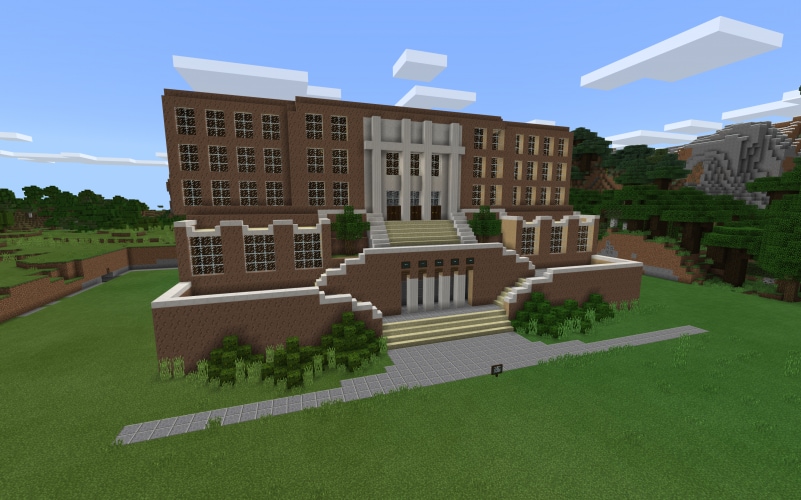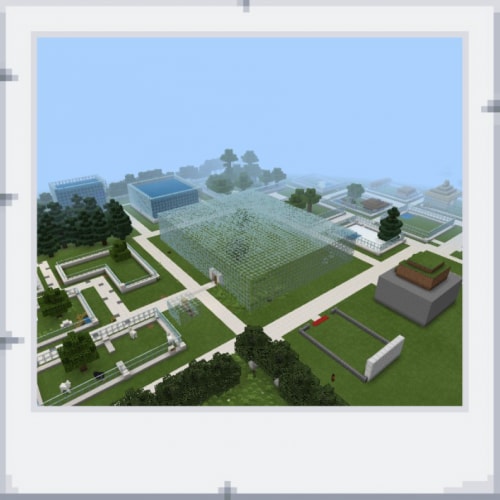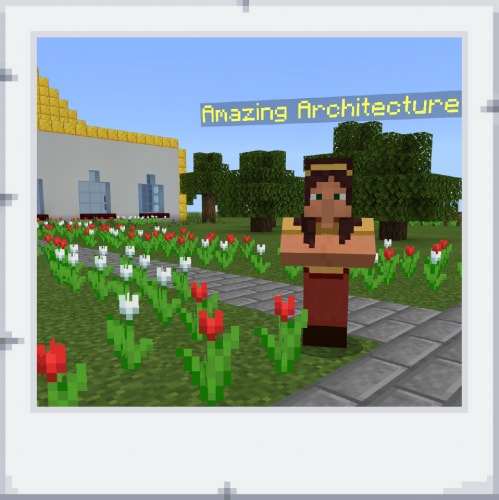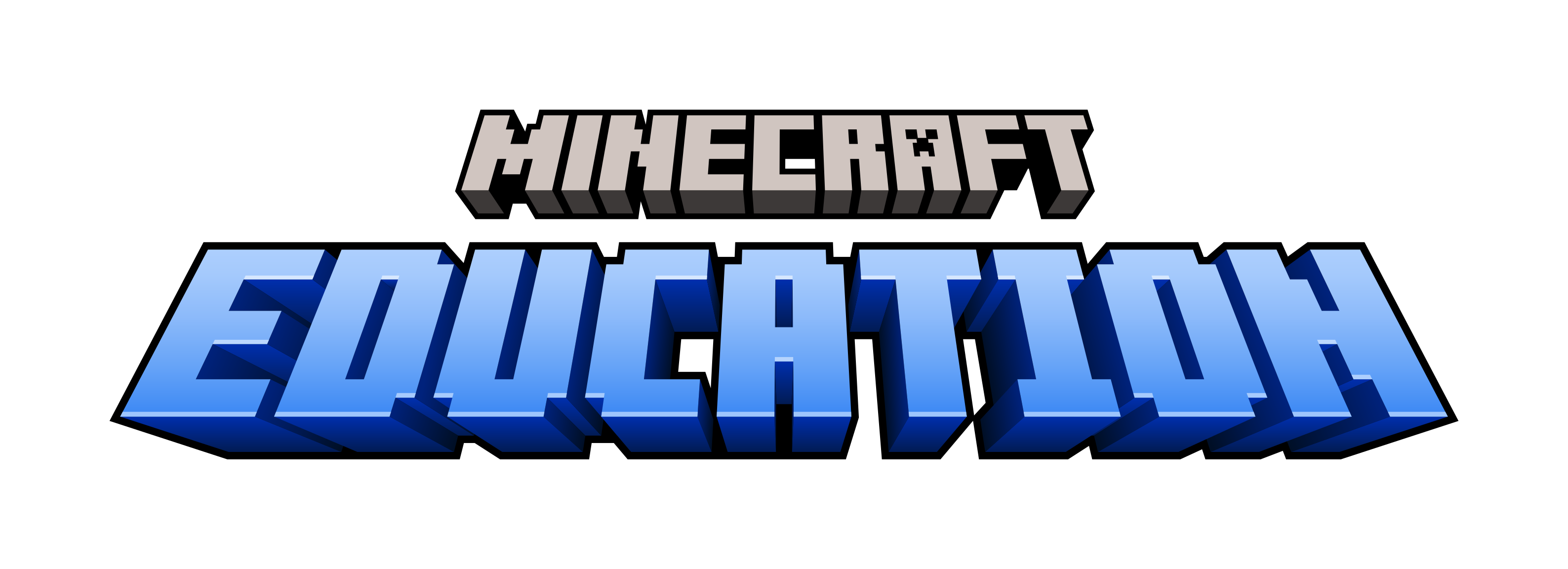Educators Across the Globe are Using Minecraft: Education Edition for Remote Learning

When schools around the world started closing in March due to the impact of COVID-19, educators had to think quickly and get creative. Many of their everyday subjects presented a challenge when it came to transferring the teaching and learning online. The physical classroom became a virtual one.
For teachers using Minecraft: Education Edition, the transition presented an opportunity for expanding the way they utilized the game as their digital learning space. We reached out to members of our community to ask how they were handling the transition, and they told us their remote learning stories. Follow along to learn about the creative ways that educators are empowering students at home!
Rural school in New York builds virtual school in Minecraft
William Dergosits is a third-grade teacher in New York who started using Minecraft: Education Edition as a tool for supporting advanced learning needs. When distance learning began, the transition to education in the home was relatively smooth.
I teach in a co-taught, special education classroom and found that the virtual platform was great for connecting students with varying social-emotional needs. I also found that many of my struggling or reluctant learners were very fluent in Minecraft since they were playing at home. This gave them a great opportunity to shine in school with their peers and engage in their academics. I’m new to this but saw that the students had a great interest and figured I would learn alongside them.
We started out with creative exploration, but since we’ve all moved into our homes, it’s been a great place to stay connected with friends, as well as a fun new classroom. Just last week, we invited the rest of our grade—we’re a small rural school with only about 60 students per grade level—to join us online, and we’re just starting to build our virtual school. This has been very well-received, as many of the students are looking for that sense of community right now. I’m excited to see where this takes us, and I’m sure there will be many more adventures while we navigate this uncharted path!

Canadian educators teach daily Minecraft lessons via Teams, boosting student engagement
Some educators were just getting started with Minecraft when remote learning became the norm, and some saw the opportunity to extend already thriving programs beyond the classroom. Kris Sandberg, Ryan Magill, and their colleague Dan McCreery from Canada worked together to make sure students could continue the kinds of projects they were working on in the classroom.
They have an especially effective process for managing distance learning. Around 25 educators use Microsoft Teams to share ideas and inspiration for teaching in a “Remote Learning with Minecraft” Team. With this background of support, these three teachers take turns hosting two Minecraft sessions per day, one in the morning and one in the afternoon. This setup provides flexibility for students who may have hectic schedules at home and gives each of the educators time to manage other projects while their learners are guided by a colleague. Kris shared their process.
We began our remote learning immediately after the March Break and were completely overwhelmed with the response from our students. We have three teachers involved, at times hosting multiple worlds to keep up with the student demand. We created a Team that students across our school board could join. Here, we communicate join codes, provide daily challenges, and troubleshoot problems with students and parents.
It’s also a place that has connected students from different parts of our city and created new friendships. Each day, students are working together collaboratively on a challenge. Their willingness to invite people into their builds and share their love and knowledge of Minecraft with others has been amazing!

We’ve also been able to connect with parents and have received a ton of positive feedback. Parents comment on how it’s a great start to their day to see their child laughing and working with someone on a challenge. This daily Minecraft: Education Edition world has provided some necessary structure and routine in their children’s lives. Teachers are reaching out to us and noticing improved attendance for online meetups and an increase in the number of assignments being completed for their homeroom teachers.
We also have a lot of first-time users, and the activities allow students to differentiate and build at their own pace. Sometimes we join in and will have eyes watching what we’re doing, and then learners will go off and try the same thing. Minecraft has really helped us stay connected in these difficult times!
Within the first week, Ryan, Kris, and Dan had 95 attendees, and the students are encouraged to invite others from outside their social group to build relationships in this new learning situation. From creating castles to conducting sustainability research within Minecraft, these students are dreaming up all kinds of ways to learn in their virtual environment, then sharing pictures of their work in Teams.
Ryan sent us a description of one project and the unexpected outcomes you can experience when you empower students to lead their own learning.
I’ve been using Minecraft for just over four years. It’s been an incredible journey, and I’m grateful for the rich experiences with the tool. As an educator, I was looking for ways to get more out of my Minecraft builds and projects. Initially, I was experiencing a ton of connection and engagement during the build but struggled to get multiple products and artifacts out of projects. Once I stepped back from the situation, I realized that the more I listened to my students’ voices and used them to help construct my projects and builds, the more I was able to do with these projects.
For example, my class was completing a biodiversity unit. Instead of simply having my students research an animal and complete a PowerPoint on it, we spent time researching their habitats, needs, and suitable living conditions. This allowed us to design an ethical zoo in Minecraft: Education Edition that showcased every animal in the game. Students constructed habitats that wouldn’t compromise their living conditions while allowing other students to learn and interact with the animals. The engagement and detail students demonstrated while researching, building, and then going through the zoo to learn about other animals was amazing.

Once I was ready to wrap this project up, I made a screen recording of our class going through the exhibits and uploaded it to YouTube. When I shared this video with students, something amazing happened. As we were ready to view the walkthrough, one of my students yelled out, “I hate these YouTube ads” while we were waiting to view our video. Within minutes of this, we were planning, scripting, and using PowerPoint screen recording to make our own YouTube ads for our zoo. Once we finished our ads, my students were so proud of everything that they were sad when we started to transition to other projects.
I reached out to a colleague at another school and offered to share our world and ads with his class. Our students created a scavenger hunt, requiring others to learn something from every exhibit and complete tasks within our zoo. We were able to share and connect with this class on Microsoft Teams. The smiles, conversations, and engagement were unlike the response to any project that I’ve completed in the past. Since this experience, I’ve continued to strive to find other cross-curricular connections that allow for these rich products that can take learning in many different directions.
Malaysian educator uses Minecraft Build Challenges to keep students inspired and connected
At a small rural school in Malaysia, Goh Kok Ming has also made the transition from Minecraft in the classroom to home learning. His students have become veteran crafters through taking part in Monthly Student Build Challenges, and now these activities have become remote collaborations. Read as Goh shares his students’ builds.
Recently, many educators have been switching to virtual or home-based learning due to temporary school closures. At times when distance learning is necessary, Minecraft Education Edition can be your virtual classroom. We are from one of the Under-Enrolled Schools in Perak, Malaysia, which consist of 24 students per school and are located in rural areas. Minecraft has made a real difference!
During school closures, my students and I have worked hard with our recent Signifying Seasons and Build a Better Bedroom Build Challenges. The whole purpose of education is to turn mirrors into windows. Minecraft inspires my students to look through a window.
They explored, learned, and created their remarkable representations of four seasons. Despite experiencing a hard time, tasks can still be accomplished remotely. There are no limits to what, where, and when my students can learn when they engage themselves in their Minecraft world.
These challenges have made them think critically and creatively to build their world. For example, they built their dream bedroom based on their own imaginations. I am so surprised with their interior design layout! Personally, this is so meaningful for me. I’m proud of them!
Students in Wales explore architecture through research-informed Minecraft projects
Finally, James Protheroe is an assistant headteacher and a leader in using Minecraft: Education Edition in Wales. He’s been spearheading the use of the game with his colleagues and shared a little bit about the projects they’re working on.
At our school, we embarked on a project called Amazing Architecture, based on the Grand Designs TV show in the UK. It’s a way for pupils to think about building and what makes structures unique or interesting, then research and plan their own. I started by building a hotel with signs and non-player characters to provide guidance. Students spawn in the world, then go on a virtual tour and use the camera and portfolio to collect info.

I use an immutable world—one that can’t be altered—so that pupils can focus on learning rather than deconstructing and reconstructing the hotel. It helps with self-regulation while they come to understand that the design stage must predate the build stage. All along, the students are collaboratively chatting and sharing their discoveries in Teams. I can track their work while they learn independently, then build something in a section of the world focused on sustainability.
This asynchronous approach is amazing for remote learning. I keep deadlines loose and let pupils learn on their own schedule. The world is available for a morning and evening session, and students share their results through either Teams or email.
We have two kids who log onto Minecraft: Education Edition every day. They’ve been researching field hospitals and building a replica of the Nightingale Hospital at the ExCel Centre. Most of the time they spend researching—they’re only in-game for about an hour a day. They create armor as a stand-in for hospital equipment. This project has really helped these two year-four pupils, aged eight and nine, understand and make sense of COVID-19. It’s the open curriculum and lack of structure that allows for this work.
There have also been some challenges for teachers. Since we’re not in the classroom, I don’t go for a blank canvas like I usually do. We must give pupils more structure and examples, which is more time-consuming. But this planning has paid off. It’s quality in, quality out from students. Parents seeing their kids using Minecraft: Education Edition at home have commented that they didn’t realize it could be used in such a productive, creative way. They hadn’t seen them engaging in such a constructive way or learning so deeply. Seeing the game in action is meaningful for parents.
We’ve built new relationships with students in this remote learning time. They’re helping one another in new ways, and it’s strengthening the relationships between teachers and students. Minecraft is helping them make sense of what’s happening. They can share their thoughts and reasoning, offload stress, and learn in a safe environment.

We were astounded by what educators have shared about their experiences with remote learning! Please continue sharing your stories with us on Twitter and Facebook using #MinecraftEdu.
If you’re inspired to try Minecraft with your distance learning students, visit this webpage to get started with Minecraft: Education Edition. Anyone with an O365 EDU account can download and use the game for free. You can also access our Minecraft remote learning toolkit and other teaching resources including more than 100 lessons, build challenges, and a guide for parents.
We hope you, your students, and your entire communities are safe and well! 


